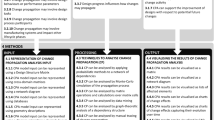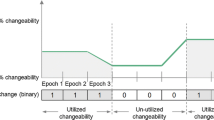Abstract
This paper presents a modelling method that seeks to support the prediction and management of undesired engineering change (EC) propagation during the design and development of complex products. The method builds on the house of quality and the change prediction method to model the effects of potential change propagation brought about by different change options. The objective is to better reflect how well each change option can address the product requirements. The method was applied to the design of a jet engine fan during a case study with an aerospace company. The findings suggest that this modelling approach is suitable for assessing the effects of potential EC propagation and can support companies in effective exploration of the design space.

























Similar content being viewed by others
References
Ahmad N, Wynn DC, Clarkson PJ (2010) Development and evaluation of a tool to estimate the impact of design change. In: Proceedings of the international design conference (DESIGN’10), Dubrovnik, Croatia
Almefelt L, Berglund F, Nilsson P, Malmqvist J (2006) Requirements management in practice: findings from an empirical study in the automotive industry. Res Eng Des 17:113–134
Ariyo OO (2007) Change propagation in complex design: predicting detailed changes cases with multi-levelled product models. PhD Dissertation, University of Cambridge
Ariyo OO, Eckert CM, Clarkson PJ (2004) Tolerance margins as constraining factors of changes in complex products. In: Proceedings of the integrated product development workshop (IPD’04), Magdeburg, Germany
Aurich JC, Roessing M (2007) Engineering change impact analysis in production using VR. In: Cunha P, Maropoulos P (eds) Digital enterprise technology: perspectives and future challenges. Springer, New York, pp 75–82
Bergsjö D, Ćatić A, Malmqvist J (2008) Implementing a service-oriented PLM architecture focusing on support for engineering change management. Int J Prod Lifecycle Manag 3:335–355
Bischof A, Blessing L (2008) Guidelines for the development of flexible products. In: Proceedings of the international design conference (DESIGN’08), Dubrovnik, Croatia
Browning TR (2001) Applying the design structure matrix to system decomposition and integration problems: a review and new directions. IEEE Trans Eng Manag 48:292–306
Clark KB, Fujimoto T (1991) Product development performance: strategy, organisation and management in the world auto industries. Harvard Business School Press, Boston
Clarkson PJ, Simons C, Eckert CM (2004) Predicting change propagation in complex design. J Mech Des 126:765–797
Cohen T, Navathe SB, Fulton RE (2000) C-FAR, change favourable representation. Comput Aided Des 32:321–338
Conrad J, Deubel T, Kohler C, Wanke S, Weber C (2007) Change impact and risk analysis (CIRA)—combining the CPM/PDD theory and FMEA methodology for an improved engineering change management. In: Proceedings of the international conference on engineering design (ICED’07), Paris, France
Coughlan PD (1992) Engineering change and manufacturing engineering deployment in new product development. In: Susman GI (ed) Integrating design and manufacturing for competitive advantage. Oxford University Press, New York, pp 157–177
Danilovic M, Browning TR (2007) Managing complex product development projects with design structure matrices and domain mapping matrices. Int J Proj Manag 25:300–314
Diprima M (1982) Engineering change control and implementation considerations. Prod Invent Manag 23:81–87
Eckert CM, Clarkson PJ, Zanker W (2004) Change and customisation in complex engineering domains. Res Eng Des 15:1–21
Eckert CM, de Weck O, Keller R, Clarkson PJ (2009) Engineering change: drivers, sources, and approaches in industry. In: Proceedings of the international conference on engineering design (ICED’09), Stanford, CA, USA
Fricke E, Schulz AP (2005) Design for changeability (DFC): principles to enable changes in systems throughout their entire lifecycle. Syst Eng 8:342–359
Fricke E, Gebhard B, Negele H, Igenbergs E (2000) Coping with changes: causes, findings and strategies. Syst Eng 3:169–179
Giffin ML, de Weck O, Buonova G, Keller R, Eckert CM, Clarkson PJ (2009) Change propagation analysis in complex technical systems. ASME J Mech Design 131. doi:10.1115/1.3149847
Gotel O, Finkelstein A (1994) An analysis of the requirements traceability problem. In: Proceedings of the international conference on requirements engineering (ICRE’94), Colorado Springs, Colorado, USA
Guenov MD, Barker SG (2005) Application of axiomatic design and design structure matrix to the decomposition of engineering systems. Syst Eng 8:29–40
Hauser JR, Clausing D (1988) The house of quality. Harv Bus Rev 66:63–73
Hedge GG, Kekre S, Kekre S (1992) Engineering changes and time delays: a field investigation. Int J Prod Econ 28:341–352
Ho CJ, Li J (1997) Progressive engineering changes in multi-level product structures. Omega Int J Manag Sci 25:585–594
Hsiao SW, Liu E (2005) A structural component-based approach for designing product family. Comput Ind 56:13–38
Isaac S, Navon R (2008) Feasibility study of an automated tool for identifying the implications of changes in construction projects. J Constr Eng Manag 134:139–145
Isaac S, Navon R (2009) Modeling building projects as a basis for change control. Autom Constr 18:656–664
Jarke M, Loucopoulos P, Lyytinen K, Mylopoulos J (2011) The brave new world of design requirements. Inf Syst 36(7):992–1008
Jarratt T, Clarkson PJ, Eckert CM (2005) Engineering change. In: Clarkson PJ, Eckert CM (eds) Design process improvement: a review of current practice. Springer, London, pp 262–285
Jarratt T, Eckert CM, Caldwell NHM, Clarkson PJ (2011) Engineering change: an overview and perspective on the literature. Res Eng Des 22:103–124
Keller R (2007) Predicting change propagation: algorithms, representations, software tools. PhD Dissertation, University of Cambridge
Kocar V, Akgunduz A (2010) ADVICE: a virtual environment for engineering change management. Comput Ind 61:15–28
Koh ECY, Keller R, Eckert CM, Clarkson PJ (2008) Influence of feature change propagation on product attributes in concept selection. In: Proceedings of the international design conference (DESIGN’08), Dubrovnik, Croatia
Kohler C, Conrad J, Wanke S, Weber C (2008) A matrix representation of the CPM/PDD approach as a means for change impact analysis. In: Proceedings of the international design conference, (DESIGN’08), Dubrovnik, Croatia
Lee GH, Kusiak A (2001) The house of quality for design rule priority. Int J Adv Manuf Technol 17:288–296
Lee HJ, Ahn HJ, Kim JW, Park SJ (2006) Capturing and reusing knowledge in engineering change management: a case of automobile development. Inf Syst Front 8:375–394
Leech DJ, Turner BT (1985) Engineering design for profit. Ellis Horwood, Chichester
Lindemann U, Maurer M, Braun T (2009) Structural complexity management. Springer, Berlin
Ma Y, Chen G, Thimm G (2008) Change propagation algorithm in a unified feature modelling scheme. Comput Ind 59:110–118
Martin MV, Ishii K (2002) Design for variety: developing standardized and modularized product platform architectures. Res Eng Des 13:213–235
Maull R, Hughes D, Bennett J (1992) The role of the bill-of-materials as a CAD/CAPM interface and the key importance of engineering change control. Comput Control Eng J 3:63–70
Ollinger GA, Stahovich TF (2004) RedesignIT—a model-based tool for managing design changes. J Mech Des 126:208–216
Palani Rajan PK, Van Wie M, Campbell MI, Wood KL, Otto KN (2005) An empirical foundation for product flexibility. Des Stud 26:405–438
Pikosz P, Malmqvist J (1998) A comparative study of engineering change management in three Swedish companies. In: Proceedings of the ASME design engineering technical conference (DETC’98), Atlanta, GA, USA
Pugh S (1990) Total design: integrated methods for successful product engineering. Addison Wesley, Reading
Rios J, Roy R, Lopez A (2007) Design requirements change and cost impact analysis in airplane structures. Int J Prod Econ 109:65–80
Rouibah K, Caskey KR (2003) Change management in concurrent engineering from a parameter perspective. Comput Ind 50:15–34
Rutka A, Guenov M, Lemmens Y, Schmidt-Schäffer T, Coleman P, Rivière A (2006) Methods for engineering change propagation analysis. In: Proceedings of the 25th international congress of the aeronautical sciences (ICAS 2006), Hamburg, Germany
Simons CS (2000) Change propagation in product design. MPhil Dissertation, University of Cambridge
Smith RP, Eppinger SD (1997) A predictive model of sequential iteration in engineering design. Manag Sci 43:1104–1120
Sudin MN, Ahmed S (2009) Investigation of change in specifications during a product’s lifecycle. In: Proceedings of the international conference on engineering design (ICED’09), Stanford, CA, USA
Suh ES, de Weck O, Chang D (2007) Flexible product platform: framework and case study. Res Eng Des 18:67–89
Sutinen K, Gustafsson G, Malmqvist J (2004) Computer support for requirements management in an international product development project. In: Proceedings of DETC’04: ASME 2004 design engineering technical conferences and computers and information in engineering conference
Tang D, Xu R, Tang J, He R (2008) Design structure matrix-based engineering change management for product development. Int J Internet Manuf Serv 1:231–245
Terwiesch C, Loch CH (1999) Managing the process of engineering change orders: the case of the climate control system in automobile development. J Prod Innov Manag 16:160–172
Ulrich KT, Eppinger SD (1995) Product design and development. McGraw-Hill, New York
Wanstrom C, Medbo P, Johansson MI (2001) Engineering change from a logistics perspective. In: Proceedings of the nordic logistics research network conference (NOFOMA), Reykjavik, Iceland
Weber M, Weisbrod J (2002) Requirements engineering in automotive development—experiences and challenges. In: Proceedings of the IEEE joint international conference on requirements engineering (RE’02)
Weber C, Werner H, Deubel T (2003) A different view on product data management/product life-cycle management and its future potentials. J Eng Des 14:447–464
Acknowledgments
The authors gratefully acknowledge the UK Engineering and Physical Sciences Research Council (EPSRC) and the industrial partners for their valuable support. The authors would also like to acknowledge Dr Tiziano Ghisu (University of Cambridge) for his precious advice in jet engine design, Dr Claudia Eckert (Open University) and Dr Rene Keller (BP) for their constructive feedback during the early stages of this work and the anonymous referees for their valuable comments and suggestions.
Author information
Authors and Affiliations
Corresponding author
Rights and permissions
About this article
Cite this article
Koh, E.C.Y., Caldwell, N.H.M. & Clarkson, P.J. A method to assess the effects of engineering change propagation. Res Eng Design 23, 329–351 (2012). https://doi.org/10.1007/s00163-012-0131-3
Received:
Revised:
Accepted:
Published:
Issue Date:
DOI: https://doi.org/10.1007/s00163-012-0131-3




